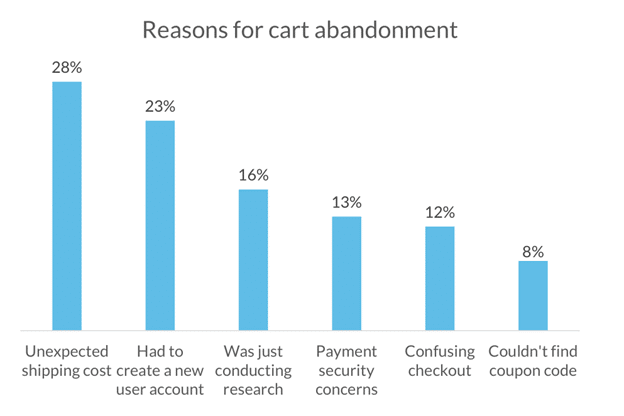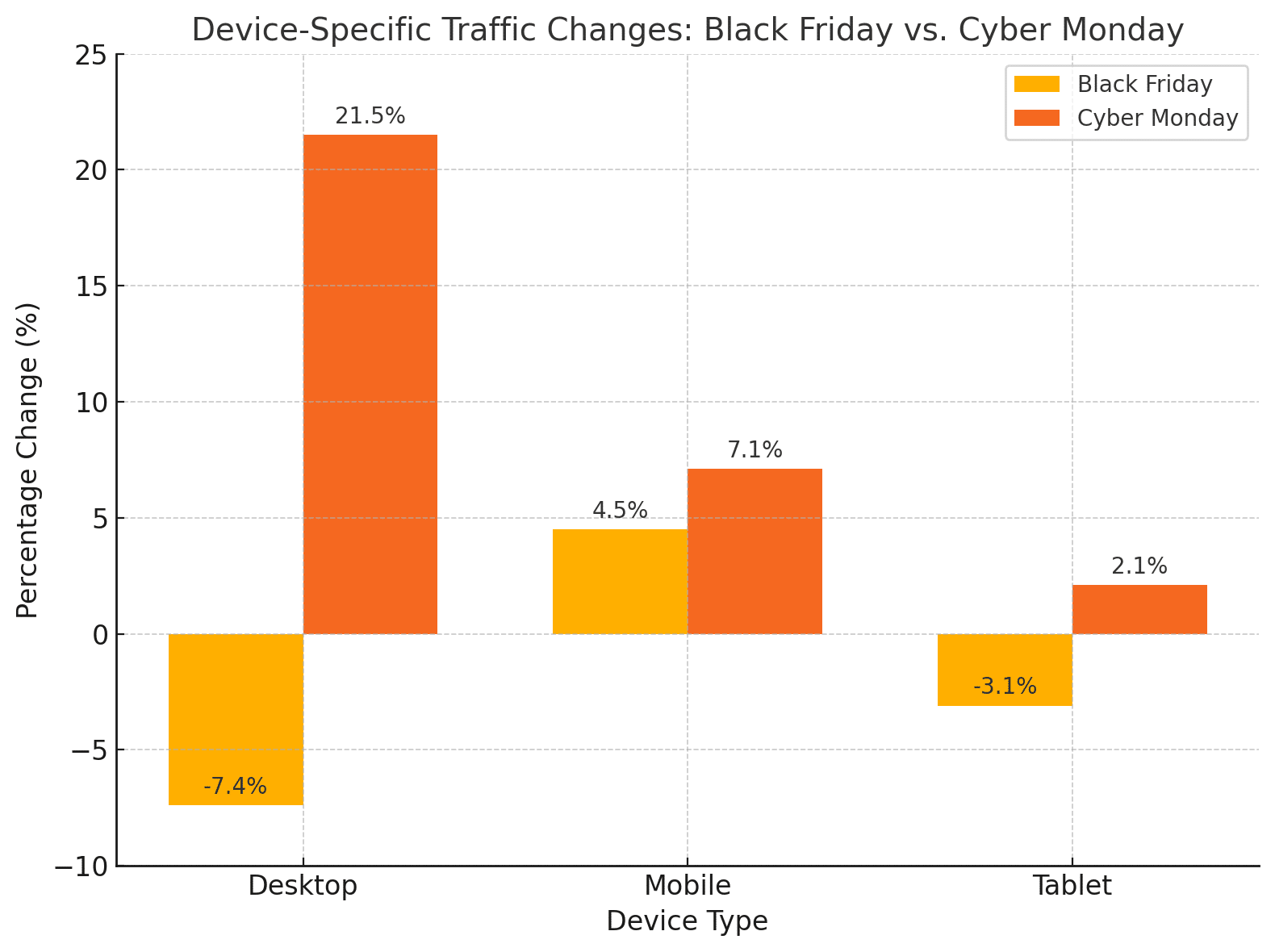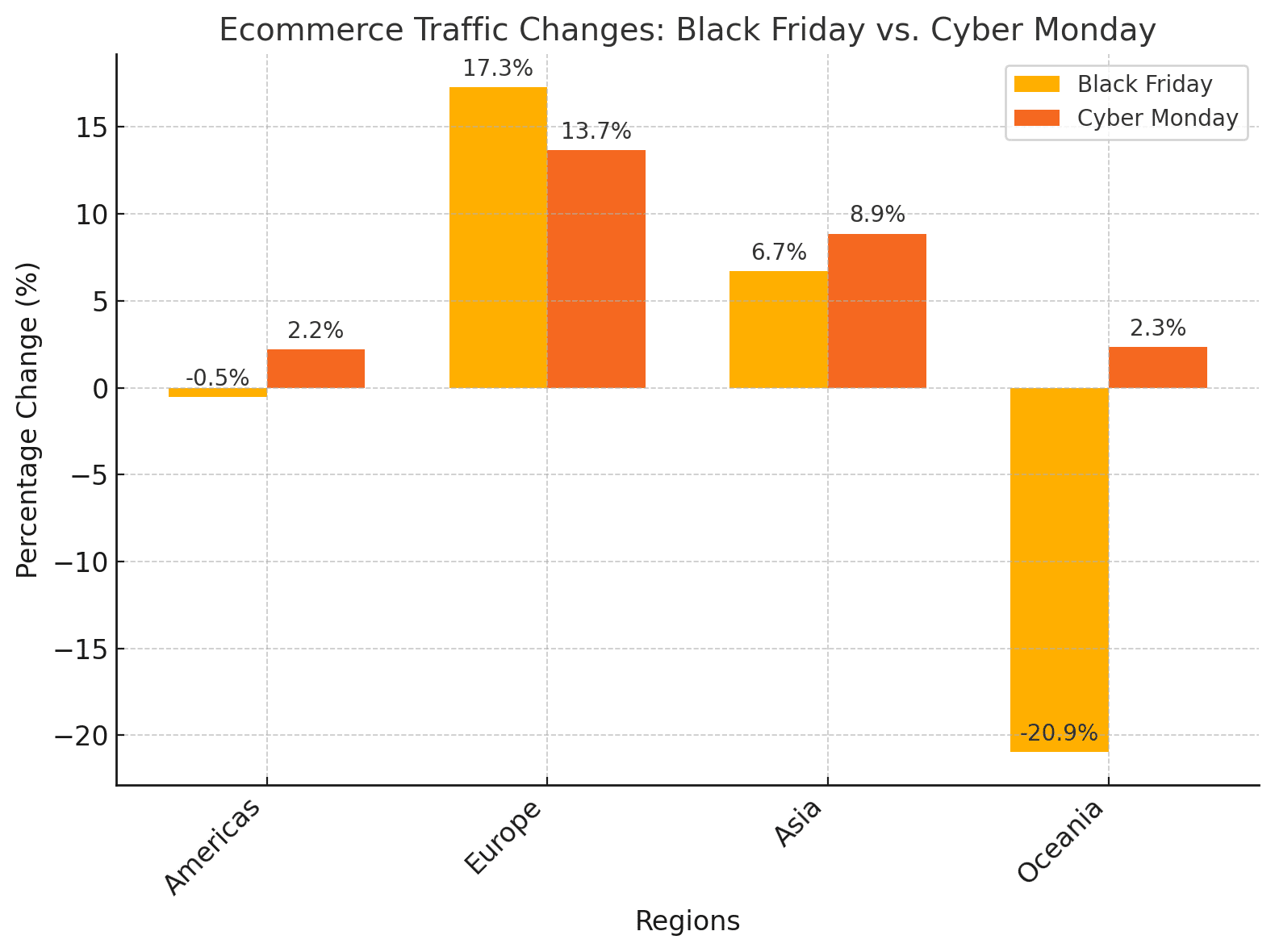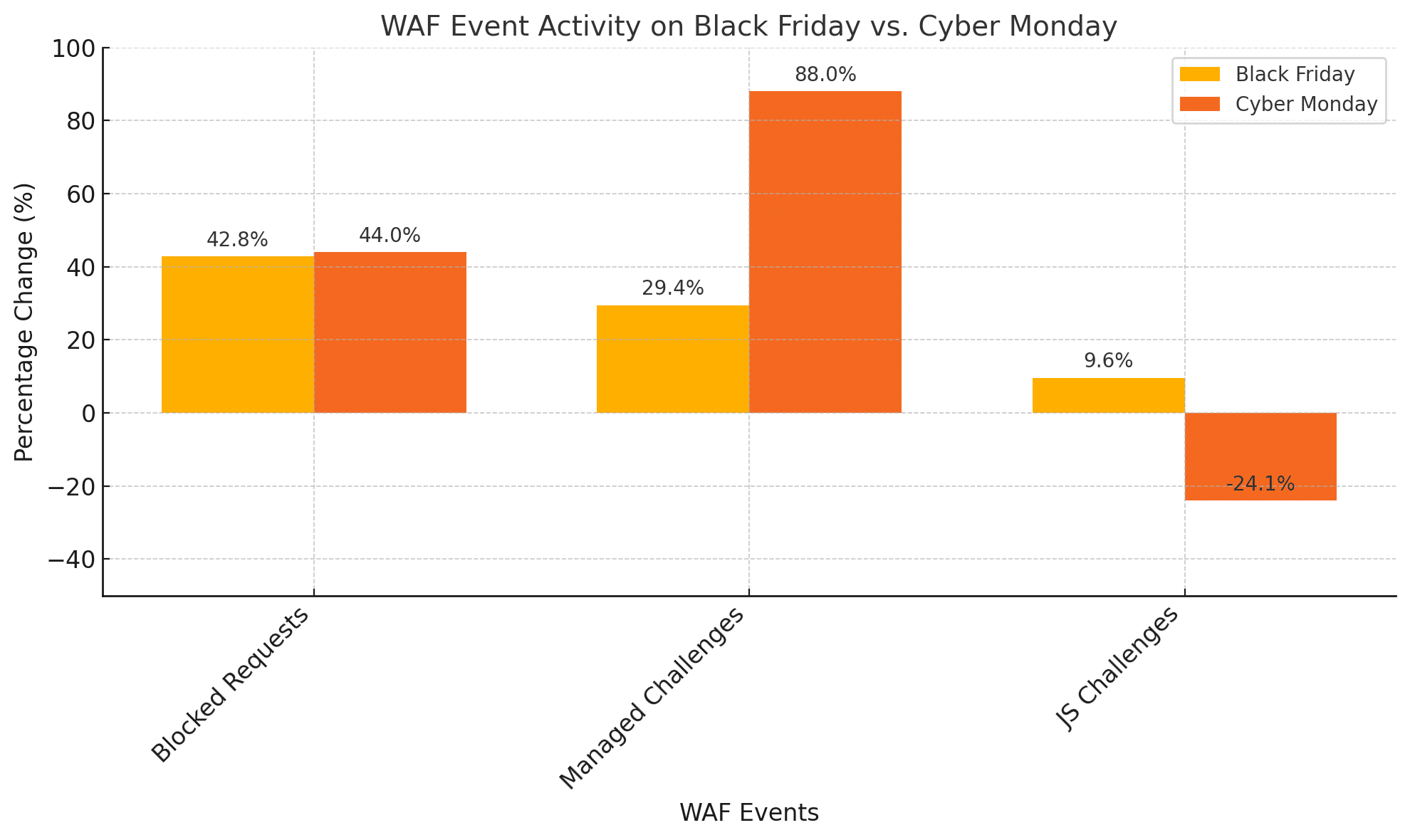Black Friday and Cyber Monday are two of the most critical periods for online activity, so we decided to analyze how these events impacted websites hosted on our platform in 2024 and share what we learned with you. To do this, we gathered detailed data from tens of thousands of websites, including many e-commerce sites, all hosted by us.
The dataset includes key metrics that help us understand how websites performed during Black Friday and Cyber Monday:
- Server requests — The total number of requests websites received.
- Bandwidth usage — How much data was transferred during peak periods.
- Cached vs. dynamic content — The split between static (cached) content and interactive (dynamic) requests, showing how users engaged with different parts of a site.
We also examined trends by region to see how different parts of the world engaged during these events and monitored security activity to understand the risks businesses face during peak traffic periods.
Our goal was simple: uncover actionable insights that show how users interact with websites during Black Friday and Cyber Monday. In this article, we’ve broken down these findings, explained what they mean for e-commerce success, and outlined practical steps you can take to optimize your site, improve performance, and maximize sales during future peak shopping seasons.
Window shoppers show up on Cyber Monday. Buyers show up on Black Friday
Our data shows that Black Friday and Cyber Monday attract different visitors. On Black Friday, shoppers are decisive: they come ready to buy. In contrast, Cyber Monday brings a surge in browsing activity as users explore options, compare products, and look for the best deals.
To illustrate this, here’s how total traffic, cached traffic, and checkout-related activity compared between Black Friday and Cyber Monday:
The chart above shows that Black Friday and Cyber Monday serve different purposes for online users. On Black Friday, total traffic dipped slightly by 4.2% compared to the baseline. At first glance, this might look like reduced engagement, but a closer look tells a different story: e-commerce traffic actually increased by 7.2%, while all other traffic fell by 9.2%.
This makes sense: Black Friday shoppers are typically on a mission. They know exactly what they want and head straight to e-commerce websites to buy it. For instance, someone waiting for a Black Friday deal on a smartphone may see a 20% discount, immediately visit the retailer’s site, and finalize the purchase. This focused behavior is further supported by the 24.1% increase in checkout activity on Black Friday. On this day, users bypass static pages like product galleries or landing pages and interact more with dynamic elements like carts and checkouts.
Cyber Monday, on the other hand, tells a very different story. Total traffic increased by 42.5%, driven by a 56.5% increase in traffic from other sites and a 10.9% rise in e-commerce activity. Cyber Monday is a browsing-heavy day. Shoppers explore multiple options, compare products and research deals.
For example, imagine a shopper looking for a new pair of running shoes. On Cyber Monday, they might visit three different websites, read reviews, and compare prices before making a final decision. While Black Friday focuses on quick purchases, Cyber Monday is about exploration, though it still converts shoppers into buyers by the end of the day. This is evident in the 21% increase in checkout traffic, showing that many users complete their purchases after thorough browsing.
How to take advantage of these insights and convert browsers into buyers on both days
To turn more visitors into buyers, you need to match their intent. Black Friday shoppers want a fast, hassle-free checkout, while Cyber Monday visitors take their time browsing. The key is to remove friction for buyers and keep browsers engaged long enough to convert. Here’s how:
1. Make checkout fast and frictionless
Because Black Friday shoppers are in a hurry, the checkout process needs to be as fast and frictionless as possible. Even minor slowdowns or unnecessary steps can cause cart abandonment.

One of the biggest mistakes businesses make is forcing users to create an account before checking out. According to a Visual Website Optimizer study, 23% of online shoppers abandon their carts when they’re required to register. Offering guest checkout makes the process much smoother — customers can complete their purchase in a few clicks without the hassle of signing up.
Speed is also critical. A slow-loading checkout page can be disastrous on Black Friday. This is why it’s essential to test your checkout flow under heavy traffic before the big day. Simulate peak loads, check for bottlenecks, and ensure your payment system doesn’t slow down or fail when it matters most.
A reliable hosting provider also plays a huge role in preventing Black Friday slowdowns. If your website can’t handle the surge in traffic, it doesn’t matter how good your deals are — customers will leave. Kinsta’s Managed Hosting for WordPress is designed to scale with demand, ensuring that sites stay fast even under extreme traffic spikes.
2. Keep Cyber Monday browsers engaged
Cyber Monday visitors aren’t just looking for discounts — they want to make sure they’re getting the best deal on the best product.
One way to keep users on your site is by offering rich content. Adding detailed product comparisons, customer reviews, and video demos can help convince hesitant buyers. If someone is browsing multiple stores looking for the best gaming headset, a comparison table that highlights key differences can save them time and push them toward making a decision on your site.
Curated collections also work well on Cyber Monday. A “Best Deals Under $50” section or blog post like this helps guide indecisive shoppers, making it easier for them to find something they like. Think about Amazon’s Lightning Deals — they’re designed to grab attention, create urgency, and keep users engaged.
3. Retarget Cyber Monday shoppers who don’t buy right away
Since Cyber Monday is full of window shoppers, businesses need to bring those visitors back. Retargeting campaigns are an effective way to do this. Abandoned cart emails can remind users about items they left behind, while push notifications can highlight price drops or limited-time discounts.
If a shopper added a pair of running shoes to their cart but didn’t check out, sending them an email with “Still thinking about these? Here’s 10% off if you complete your purchase today” can be the push they need.
Live chat can also help move hesitant Cyber Monday shoppers toward checkout. Many visitors abandon purchases simply because they have unanswered questions about product details, shipping, or return policies. Offering instant support through live chat can prevent those doubts from turning into lost sales.
4. Automate follow-ups to capture more sales
Finally, marketing automation can make all the difference. Cyber Monday visitors often leave a site without buying anything, but that doesn’t mean they’re gone forever. By using automated email sequences, businesses can follow up with tailored offers, restock notifications, and exclusive post-sale discounts to encourage conversions even after the event is over.
For example, sending a “Cyber Monday Extended: Extra 15% Off Today Only” email the next day can bring back users who hesitated to purchase. Some businesses also send VIP discount codes to first-time shoppers, turning them into repeat customers.
Desktop takes the lead on Cyber Monday
When it comes to Black Friday and Cyber Monday, one trend is undeniable: desktop traffic plays a key role, especially on Cyber Monday. While mobile and tablet devices remain important, the data reveals that desktop usage surges during Cyber Monday, making it the device of choice for research-heavy and checkout activities.
Let’s break it down:

The chart above reveals a striking 21.5% increase in desktop traffic on Cyber Monday. This shows that desktops play a pivotal role in helping shoppers engage with websites, especially for research-heavy tasks like comparing products, reading reviews, and exploring detailed content.
On Black Friday, however, desktop traffic decreased by 7.4%. This suggests that shoppers relied more on mobile devices for quicker, more spontaneous purchases. Mobile traffic grew by 4.4% on Black Friday and by 7.1% on Cyber Monday, showing its consistent importance for on-the-go browsing and impulse buying.
Tablet traffic was relatively stagnant, with a 3% decline on Black Friday and a 2.1% increase on Cyber Monday. This indicates that tablets are less significant compared to desktops and mobiles, with shoppers favoring devices that better suit their specific needs during these events.
What this means for e-commerce websites
This shift in device preference across both shopping days presents key opportunities for e-commerce businesses to optimize their experience across platforms.
1. Leverage desktop’s Cyber Monday dominance
Cyber Monday is a research-heavy day, and shoppers expect detailed product pages, comparison tools, and an intuitive checkout process.
Ensure your desktop site is optimized for longer browsing sessions with high-resolution images, clear product descriptions, and easy filtering options. If you offer bundles or product recommendations, make them visible on the desktop where users are more likely to explore multiple options before purchasing.
2. Optimize mobile for Black Friday’s fast-paced buying
Since Black Friday sees more mobile engagement, make sure your mobile checkout is as quick and frictionless as possible. Reduce form fields, enable guest checkout, and ensure the mobile UI makes it easy to add products to the cart with minimal clicks.
A one-click checkout option or express payment integrations like Apple Pay or Google Pay can greatly improve mobile shoppers’ retention rates.
3. Consider targeted promotions by device
Knowing that Cyber Monday users favor desktops and Black Friday shoppers rely more on mobile, you can tailor promotions accordingly. For example, offering desktop-exclusive Cyber Monday deals or mobile-only Black Friday flash sales could drive conversions by matching user behavior.
Holiday shopping is a global phenomenon
Black Friday and Cyber Monday might have started as U.S.-centric shopping events tied to that country’s Thanksgiving holiday, but today, they’re truly global. The e-commerce traffic data from Kinsta-hosted sites in 2024 during the Black Friday and Cyber Monday period reveals how these events resonate differently across regions, painting a vivid picture of worldwide engagement.
Here’s what the e-commerce-specific data tells us about regional trends during Black Friday and Cyber Monday:

The above chart shows fascinating differences in how regions engaged during these shopping days.
In the Americas, Black Friday e-commerce traffic stayed relatively flat at -0.5%, but Cyber Monday saw a modest increase of 2.2%. This suggests that while Black Friday remains a critical shopping day, e-commerce activity in the region has stabilized, with Cyber Monday offering a slight boost in online engagement.
Europe, on the other hand, displayed strong enthusiasm for Black Friday, with e-commerce traffic growing by 17.3%. Cyber Monday saw an additional 13.7% increase, indicating that European shoppers actively participate in both shopping events.
Asia showed steady growth across both days, with e-commerce traffic rising by 6.7% on Black Friday and 8.9% on Cyber Monday. This consistent engagement reflects Asia’s growing adoption of global shopping events!
Oceania saw a sharp 20.9% drop in e-commerce traffic on Black Friday, but Cyber Monday offered a slight recovery with a 2.3% increase. This pattern could suggest that Black Friday is yet to establish itself as a key e-commerce event in this region, while Cyber Monday shows a slightly stronger connection to digital-first shopping behaviors.
What this means for e-commerce businesses
This variation in shopping behavior across regions presents a unique opportunity for e-commerce businesses. For businesses expanding internationally, understanding these trends can help tailor promotions and marketing efforts to better align with customer expectations.
1. Expand your target markets
If your business serves Europe and Asia, your best bet is to invest heavily in localized Black Friday and Cyber Monday campaigns. Localized deals, currency-based discounts, and geo-targeted ads can make all the difference in connecting with shoppers who are now fully engaged in these events.
Meanwhile, for businesses focusing on the Americas, steady engagement across both days means promotions should be balanced, with Cyber Monday treated as an equally significant revenue driver.
2. Capitalize on Cyber Monday’s global growth
While Black Friday attracts decisive buyers, Cyber Monday is all about browsing and deal-hunting. This makes it the perfect time for retargeting campaigns, reminding visitors about the products they checked out but didn’t buy.
Offering exclusive discounts to email subscribers or personalized offers based on browsing behavior can significantly increase Cyber Monday conversions. Since shoppers are more exploratory on this day, providing limited-time flash deals or extended sales into Tuesday can also help capture those last-minute buyers.
3. Leverage regional differences to drive engagement
The way different regions interact with these shopping events gives a clear roadmap for marketing strategies. If you’re targeting Asia and Europe, you should start running promotions earlier in November to capture the excitement as Black Friday gains traction there.
In Oceania, where Black Friday isn’t as popular, building awareness through content marketing, educational campaigns, and early-bird vouchers can help establish these events. Pre-sale marketing with countdown timers and teaser campaigns will also get more people engaged leading up to the sales.
For example, you can create content like “Your guide to the best Black Friday & Cyber Monday deals” to get shoppers excited before the sales even start.
4. Use affiliates and social proof to boost conversions
Regions where Black Friday and Cyber Monday are still growing, like parts of Asia and Oceania, rely heavily on trust signals when making purchase decisions.
Partnering with local influencers, affiliate marketers, and regional content creators can help bridge that trust gap and drive sales. If shoppers see people they trust recommending deals, they’re more likely to buy.
Displaying real-time purchase notifications, customer reviews, and “low stock” alerts can further build urgency and push hesitant buyers toward checkout.
5. Prepare for global scalability
Cyber Monday generated massive traffic spikes in Asia, Europe, and the Americas, proving that global e-commerce infrastructure needs to be ready for these surges.
Businesses should invest in high-performance hosting, a robust CDN (Content Delivery Network), and scalable servers to handle increased traffic without slowdowns.
Kinsta’s hosting, powered by a Cloudflare-integrated CDN with over 260+ global locations, ensures fast load times and reliability during high-traffic events. This means your site stays responsive, no matter where your customers are shopping from.
Protect your website or suffer the consequences
Black Friday and Cyber Monday are the most exciting days for e-commerce, but they’re also the most dangerous. As traffic surges, so do cyberattacks! From bot traffic trying to game discount systems to DDoS attacks that crash sites, malicious activity peaks right when your customers need you the most.
The numbers don’t lie. During Black Friday and Cyber Monday in 2024, WAF (Web Application Firewall) events at Kinsta spiked dramatically:

In the chart above, blocked requests rose significantly, with a 42.8% increase on Black Friday and a 44.0% rise on Cyber Monday. These numbers highlight a consistent effort by malicious actors to overwhelm websites, particularly during the busiest e-commerce days of the year.
Managed challenges, which evaluate user behavior to detect bots, also saw sharp increases. Black Friday experienced a 29.4% rise, while Cyber Monday spiked dramatically by 88%. This suggests a surge in bots trying to scrape data, test vulnerabilities, or manipulate dynamic elements like search filters during these shopping events.
Interestingly, JavaScript challenges, another bot detection method, showed a 9.6% increase on Black Friday but decreased by 24.1% on Cyber Monday. This drop indicates a shift in attack strategies, with attackers likely focusing on bypassing other layers of security rather than triggering JavaScript-based detection mechanisms.
These patterns demonstrate that as legitimate traffic surges, so do attempts to exploit it. Your business needs to be prepared, as downtime or vulnerabilities during these critical moments can lead to lost revenue, frustrated customers, and long-term damage to their reputation.
How to keep your store safe
The worst time to think about website security is when an attack is already happening. Black Friday and Cyber Monday bring massive surges in traffic, but as the data shows, they also attract bad actors looking for vulnerabilities to exploit.
Whether it’s bot-driven fraud, brute-force login attempts, or full-scale DDoS attacks, your site needs to be ready before the rush begins. If your store goes down or gets compromised, you don’t just lose sales — you risk damaging customer trust permanently.
Here’s what you need to do to keep your store safe:
1. Block threats before they reach your site with a WAF
Hackers don’t wait until your site is ready — they start probing for weaknesses weeks before major shopping events.
A WAF acts as a security checkpoint, filtering out malicious traffic before it can do damage. During Black Friday and Cyber Monday, blocked requests jumped over 40%, proving that attackers ramp up their efforts during these periods. If you don’t have a WAF in place, you’re giving them an open door.
At Kinsta, our Cloudflare-powered WAF automatically blocks suspicious traffic before it ever hits your site, keeping both customers and transactions safe.
2. Make sure your website can handle the traffic surge
A site crash doesn’t just frustrate shoppers — it hands them over to your competitors. Black Friday and Cyber Monday bring a flood of visitors, and if your infrastructure isn’t built to handle the load, slowdowns, checkout failures, and full-on downtime become real risks.
Using a CDN distributes traffic across multiple locations, reducing server strain and keeping load times fast. If you’re on shared hosting or a provider that struggles with high traffic, it’s time to reconsider.
3. Keep an eye on login activity and bot traffic
Many attacks start small, with cybercriminals testing weak credentials or overwhelming login pages with bots. If your store isn’t monitoring these patterns, you won’t notice the warning signs until real damage is done.
Watch for unusual login attempts, rapid spikes in bot activity, and unexpected surges in failed transactions. Setting up alerts for suspicious activity helps you act before a full-scale attack takes hold.
4. Don’t leave security gaps in outdated software
One of the easiest ways hackers gain access to sites is through outdated WordPress installations, plugins, and themes. If you haven’t updated in a while, you’re running with known vulnerabilities that attackers actively target.
Updating to the latest WordPress version, switching to a supported PHP version, and regularly checking for plugin updates closes the gaps before they can be exploited.
5. Lock down your admin login
Weak passwords and default usernames like “admin” are gift-wrapped invitations for hackers. Brute-force login attempts skyrocket during major shopping events, as attackers try to break into admin accounts. Secure your store by:
- Changing your username to something unique.
- Using a strong password with uppercase, lowercase, symbols, and numbers.
- Enabling two-factor authentication (2FA) so even stolen passwords aren’t enough to log in.
6. Secure customer data with SSL encryption.
Shoppers won’t trust an unsecured checkout. If your site doesn’t have SSL (HTTPS), browsers will warn customers that their data isn’t safe — leading to abandoned carts and lost sales.
More importantly, SSL encrypts sensitive data like credit card details, protecting customers from interception. If you’re still running without SSL, it’s time to fix that immediately. Kinsta provides free SSL certificates, so there’s no excuse to skip this.
7. Choose hosting that doesn’t leave security up to you.
Security shouldn’t be an afterthought, and it shouldn’t be your full-time job either. Your hosting provider should proactively handle security by offering firewalls, DDoS protection, automated updates, and real-time monitoring.
If something goes wrong, you need a team that responds instantly — not one that leaves you hanging. Kinsta includes enterprise-grade security and 24/7/365 support from real humans, so when attacks peak, your site stays online while others go down. Whether it’s the middle of the night or peak shopping hours, you’ll always have experts ready to help.
Summary
Black Friday and Cyber Monday bring immense opportunities for e-commerce businesses but demand careful preparation.
Slow load times, downtime, or security breaches can quickly turn a record-breaking sales day into a disaster. Reliability is everything. Your hosting provider should not only handle traffic surges but also offer 24/7 human-only support, so if anything goes wrong, you have real experts ready to help — no bots, no delays.
With Kinsta, you get high-performance hosting for e-commerce, plus free migrations, so you can switch with zero hassle. Need more power? Our PHP Performance Add-on also boosts memory and threads for your sites. Let us handle the infrastructure while you focus on growing your business. Migrate to Kinsta today.

